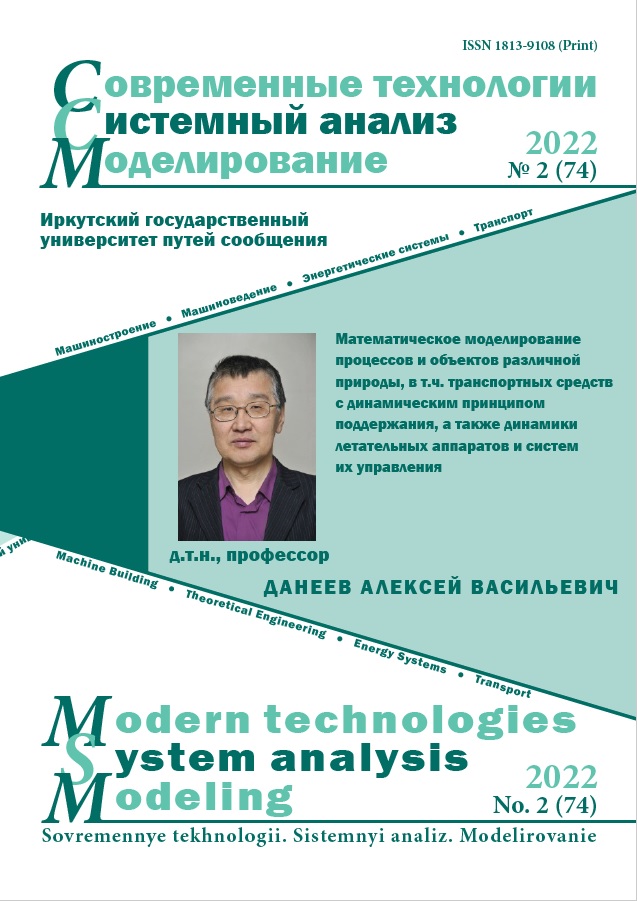Analysis of factors affecting the coefficient of friction of the brake pad of rolling stock
Keywords:
rolling stock of railways, the coefficient of friction of the pad on the wheel, the coefficient of adhesion of the wheel with the rail, braking efficiencyAbstract
Today one of the limiting factors in increasing the local and maximum train speeds, which directly affect the profit of the railway company, is braking efficiency. The pad in the brake system is the first direct element that forms friction on the rolling surface of the rotating wheel, and the brake lever gear and brake cylinders serve solely to ensure that the brake pad is pressed with the required force. If the brake pads are absent, friction is not feasible and all other devices are designed directly to control the friction force in relation to its magnitude and duration. The coefficient of friction plays an important role in the formation of the braking force, which also determines its magnitude. In this article, we examined various methods for determining the coefficient of friction, as a result of which the dependences of the influence of factors such as the force of pressing the pad on the wheel, the chemical composition of the pad, the shape of the pad, the degree of moisture of the pad, the wear of the pad, the initial duration of friction were revealed; the temperature of the pad and the rolling surface of the wheel by the value of the coefficient of friction. These issues were dealt with by both domestic scientists, such as M. Metskov, V.F. Egorchenko, and foreign scientists, the most prominent representative is Galton. Despite the significant contribution made by the scientists represented, it is necessary to continue research in this area in order to increase the speed of movement of rolling stock and related other operational indicators, which will directly affect the increase in profits of JSC "Russian Railways" and reduce various economic losses.
References
Карвацкий Б.Л. Общая теория автотормозов. М. : Трансжелдориздат, 1947. 300 с.
Распоряжение ОАО «РЖД» 867р от 12.05.2016 (ред. 02.02.2018) «Об утверждении правил тяговых расчетов для поезд-ной работы». М. : ОАО «РЖД», 2016. 515 с.
Иванов П.Ю., Корсун А.А., Емельянов Д.О. Существующие способы управления тормозным нажатием с повышенной эффективностью // Сборник статей XV Международной научно-практической конференции «Научные междисциплинарные иссле-дования». Саратов, 10 июня 2021 года. Москва: «КДУ», «Добросвет», 2021. С. 28-36.
Исследование работы стабилизатора крана машиниста / П.Ю. Иванов, Е. Ю. Дульский, Н.И. Мануилов, А.М. Худоногов // Материалы II Всероссийской научно-технической конференции «Инновационные проекты и технологии машиностроительных производств». Омск, 19–20 октября 2017 г. Омск: ОмГУПС, 2017. С. 62-69.
Исследование температуры тормозных колодок с разной степенью износа в процессе фрикционного торможения /
П.Ю. Иванов, А. М. Худоногов, Е. Ю. Дульский [и др.] // Вестник Уральского государственного университета путей сообщения. 2020. № 3(47). С. 27-34. DOI 10.20291/2079-0392-2020-3-27-34.
Иванов П.Ю., Хамнаева А.А., Худоногов А.М. Снижение энергопотребления электровоза при управлении пневматиче-скими тормозами грузового поезда // Материалы III международной научно-практической конференции «Разработка и эксплуата-ция электротехнических комплексов и систем энергетики и наземного транспорта». Омск, 06 декабря 2018 года. Омск: ОмГУПС, 2018. С. 143-151.
Abbasia S., Teimourimaneshb Sh., T. Vernerssonb,c, Ulf. Sellgrena, Ulf. Olofssona, R. Lundénb, “Temperature and thermoelas-tic instability at tread braking using cast iron friction material”, Wear, vol. 314, pp. 171-180, 2013
A. Hamdaoui, El.H. Jaddi, “Effects of the brake shoe friction material on the railway wheel damage”, MATEC Web of Confer-ences, vol. 149, pp. 1-4, 2018
Evtushenko O.O., Ivanyk E.H., Horbachova N.V., «Analytic methods for thermal calculation of brakes (review)», Materials Sci-ence, vol. 36, No. 6, pp. 857-862, 2000.
M. Petersson, «Two-dimensional finite element simulation of the thermal problem at railway block braking», Mechanical Engi-neering Science, vol.216, pp. 259-273, 2015.
Z. Li, J. Han, Z. Yang, L. Pan, “The effect of braking energy on the fatigue crack propagation in railway brake discs", Engineer-ing Failure Analysis, vol. 44, pp. 272-284, 2014
A. Esmaeili, M.S. Walia, K. Handa, K. Ikeuchi, M. Ekh, T. Vernersson, J. Ahlström, “A methodology to predict thermome-chanical cracking of railway wheel treads: from experiments to numerical predictions”, International Journal of Fatigue, vol. 105, pp. 71-85, 2017
P. Wasilewski, «Frictional heating in railway brakes: a review of numerical models», Archives of Computational Methods in Engineering, vol. 58, pp. 45-58, 2020.
J.G. Balotin, P.D. Neis, N.F. Ferreira, “Analysis of the influence of temperature on the friction coefficient of friction materials”, ABCM Symposium Series in Mechatronics, vol. 4, pp.898-906, 2010
F. Talati, S. Jalalifar, “Analysis of heat conduction in a disk brake system”, Heat Mass Tranfer, vol. 45, pp. 1047-1059, January 2009.
L. Cantone, A. Ottati, “Modelling of friction coefficient for shoes type LL by means of polynomial fitting”, The Open Transpor-tation Journal, vol. 12, pp. 114-127, 2018.
N. Meysam, A.Z. Jabbar, Sh. Morad, E. Morteza, “3D dynamic model of the railway wagon to obtain the wheel–rail forces un-der track irregularities”, Proc. IMechE Part K: journal of Multi-Bodies Dynamics, pp. 1-13, vol. 252, 2015.
Y.P. Wei, Y.P. Wu, “Thermal and mechanical characteristics of contact friction pair based on 3-D wheel/rail-foundation contact vertical system”, IOP Conf. Series: Materials Science and Engineering, vol. 657, pp.1-9, August 2019.
O. Polach, “Influence of locomotive tractive effort on the forces between wheel and rail”, Vehicle System Dynamics Supple-ment, vol. 35, pp. 7-22, 2001.
A. Tudor, C. Radulescu, I. Petre, “Thermal effect of the brake shoes friction on the wheel/rail contact”, Tribology in industry, vol. 25, pp. 27-32, 2003.
Дульский Е.Ю. Энергоаудит безразборной технологии ремонта // Мир транспорта. 2012. Т. 10. № 3(41). С. 168-171.


